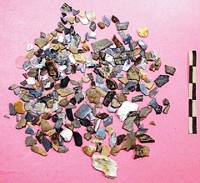Advertisement
Grab your lab coat. Let's get started
Welcome!
Welcome!
Create an account below to get 6 C&EN articles per month, receive newsletters and more - all free.
It seems this is your first time logging in online. Please enter the following information to continue.
As an ACS member you automatically get access to this site. All we need is few more details to create your reading experience.
Not you? Sign in with a different account.
Not you? Sign in with a different account.
ERROR 1
ERROR 1
ERROR 2
ERROR 2
ERROR 2
ERROR 2
ERROR 2
Password and Confirm password must match.
If you have an ACS member number, please enter it here so we can link this account to your membership. (optional)
ERROR 2
ACS values your privacy. By submitting your information, you are gaining access to C&EN and subscribing to our weekly newsletter. We use the information you provide to make your reading experience better, and we will never sell your data to third party members.
Art & Artifacts
Solvent mixture may help pry protein clues from ancient pots
Cooking experiments suggest that deep eutectic solvents could recover molecules that reveal past diets
by Carolyn Wilke, special to C&EN
November 9, 2022

For a couple of decades, researchers have been scouring ancient proteins stuck to culinary pots for hints at what people ate in ages past. Now a team of scientists has found that a solvent mixture may improve the recovery of proteins from such archaeological samples (J. Proteome Res. 2022, DOI: 10.1021/acs.jproteome.2c00340).
For objects such as bone fragments that are expected to contain proteins, ancient protein analysis has provided a wealth of new insights. But for ceramics that might have retained residues of prepared foods on them, “we really haven’t been able to apply proteins very successfully,” says Matthew J. Collins, an archaeological scientist who works at the University of Cambridge and the University of Copenhagen and wasn’t part of the new study.
“We know that the present extraction methods cannot extract all the proteins that are adsorbed,” says University of Manchester bioarcheologist Manasij P. Chowdhury. Proteins are often bound to ceramic pots by ionic interactions and possibly hydrogen bonds. The new technique could help liberate more leftover proteins from foods like cereals, which have been difficult to identify based on their low levels of lipids, another commonly measured biomolecule.
In this latest work, Chowdhury and colleagues used a specifically proportioned mixture of a base and an acid called a deep eutectic solvent—in this case, urea mixed with a conventional protein extraction solvent, guanidine hydrochloride. Deep eutectic solvents usually have strong hydrogen bonding between their components, so the researchers wondered whether that bonding power could be used to disrupt the bonds between proteins and ceramics.
To compare the performance of a deep eutectic solvent with that of guanidine hydrochloride alone, Chowdhury’s team cooked up meals in unglazed ceramic pots. In commercial pots, they repeatedly simmered mixtures of ground meats with crushed grains and milk. Then, working with colleagues studying the subsistence strategies of the Yugan Khanty people in Siberia, the team also made stews in replicas of archaeological pots using a wood-fired oven and ingredients gathered by local fishers and hunters.
For each set of experiments, Chowdhury’s team ground up pieces of the pots and extracted their proteins. For most samples, they found that the deep eutectic solvent recovered two or more times as many protein molecules than guanidine hydrochloride alone.
It’s important to try new methods for extracting proteins, says Anna Shevchenko, a biochemist at the Max Planck Institute of Molecular Cell Biology and Genetics. “Each bit which we recover will help us,” though she notes that the team used relatively large ceramic pieces for this work.
The team has yet to show that the process provides similar improvements in protein extraction for real archaeological samples. But “this is really encouraging,” Collins says. “Many sites are just stuffed full of ceramic shards. So it’s not that these things are difficult to get hold of and rare.” It could be a step on what’s been a long road to routinely recovering proteins from ceramics, he says.




Join the conversation
Contact the reporter
Submit a Letter to the Editor for publication
Engage with us on Twitter